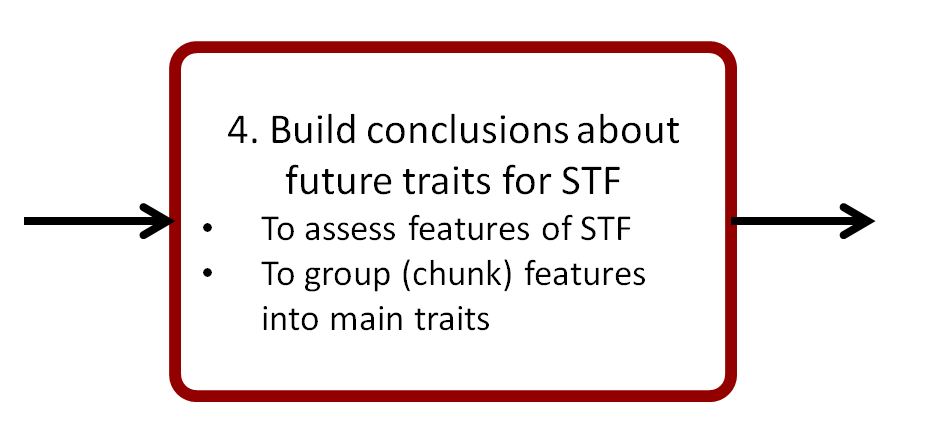Clear description of results from Stage M Add a Tooltip Text and Steps 1, 2, 3 of Stage A A = Act has to be prepared.
The developed results should be checked for consistency and coordinated. The consensus among members of working team should be attained for results within Step 4.
Method
The fourth step of Stage A A = Act
synthesizes the output of the forecast based on the elaborated results of the previous steps. The main task is to integrate the outcomes of the previous activities, check their consistency and identify the main features (traits) of the STF for the defined time horizon in specified location.
Instructions
- Examine the outcomes of Step 5 in Stage M and Steps 1-3 in Stage A.
- Distinguish between compliant, complementary and conflicting features of the STF:
- compliant features are those emerging as plausible future traits of the STFSTF = System to be forecasted according to two or more steps of performed study;
- complementary features are those identified within one step of performed study, and they are not in conflict with any other statement provided by the others;
- conflicting features are those that derive from opposite conclusions drawn from any pair of performed steps.
- Check measurability and assign measurement units for elaborated traits. Reformulate or regroup features for new traits, if necessary from measurability viewpoint.
- Check consistency of formulated traits with time horizon and specified location of future STFSTF = System to be forecasted .
Tips
➔ The compliant features clearly allow to draw the most reliable statements about the STF, while the conflicting features deserve further investigation (e.g. in a second round of the entire FORMAT process if requested by the beneficiaries).
➔ It is recommended to group the features so as have 5-7 main traits of the future STF. This is meant to improve readability and interpretation of the forecast.
➔ Whole set of traits is recommended to structure by three categories: (1) the features of future STF; (2) the features of future super-systems; (3) identified characteristics of sub-systems.
➔ Traits may include sub-features. Any features and sub-features have to be accompanied with measurement units to allow comparison with alternative systems, if required.
➔ It is necessary to check the future traits of the STF for conformity with changes on the super-system level and in the sub-system level.
➔ Future traits of the STF have to be coordinated with features of the super-systems and harmonized with features of sub-systems of the future.
➔ When future traits of STF are defined, they have to be checked first of all for consistency with results of Steps 1, 2, 3 of Stage A.
➔ Participation of users of the forecast in the finalization of the outcomes of Step 4 of Stage A improves clarity of conclusions and consistency with common practices of the company.
Suggested reading
[1] ENV Model in G. Cascini, F. S. Frillici, J. Jantschgi, I. Kaikov, and N. Khomenko, TETRIS: Teaching TRIZ at School, EN 1.0. TETRIS project and the Lifelong Learning Programme, 2009. (pp.20-24) http://www.tetris-project.org/ [2] OTSM ENV Fractal Model in N. Khomenko, Keynote presentation for 6th TRIZ Symposium in Japan, Tokyo, September 2010 (pp.31-39).
Example
While analysing technologies for the decoration for household appliances the following future trends (next 10 years) for super-systems where recognised among others not included for a matter of confidentiality:
- Home appliances produced by complementary manufacturers (e.g. furniture maker + household appliance producer)
- Integrated aesthetically, electronically and by data- information
- Appliances will provide more information (more sensors & data)
- Control Panel (CPCP = Control Panel ) has to deliver more information and control
- User manipulation and control (easy to setup)
- More touch-screen experiences.
- New Options are attractive
- Easy to use.
- To attract customer the parameters:
- aesthetic,
- novelties,
- smart energy consumption;
- improved chemical. resistance
will be more important.
- Recyclability of parts will be more important
- Gradation of color in the design of CP CP = Control Panel will be more important.
- User will be capable to create their own CP CP = Control Panel for more products
- Most of decoration of CP CP = Control Panel with an electronic User-Interface (multi-language)
- Company authenticity (brand, logo, look of products) will be more recognizable.
Meanwhile, future trends for sub-systems were formulated as:
- More diversity of applied technologies for different substrates (various materials, shapes) and for diverse products.
- Time form operator’s involvement will decrease;
- Preprocess time to prepare decoration will decrease
Consequently the Future traits of Decoration system (main function: <to modify><color of><a surface> where formulated for first version the following way:
- Output of decoration will be more dynamic (easy to be modified when necessary)
- Decoration process will be performed:
- without stock,
- in-line ,
- with increased recyclability of equipment and tools,
- with reducedenergy consumption.
- Special investment for equipment, human resources (HRHR = human resources ) and maintenances will be allocated.
- Investment to new technology tends to be lower (below alternatives when delivering the same result),
- operation cost is going to decrease,
- environmental impact will decrease
- Back side of Intermediate layer will be used for decoration more frequently than nowadays.
- Full range of color management including metallic will be on demand,
- Digital printing (no image preparation) will be wider applied:
- change over time=0s,
- change over time for a part type t=0s
- Productivity of process [pcs/h] will be close to single colour silk screening
- no scrap during
- Maintainability [non working, h] tends to improve due to self-maintainability
- Cycle time of decoration process tends to be coordinated with cycle time of production line towards full integration of decoration with production line
The list of future traits above is a preliminary one. A more elaborated list of traits with measurable characteristics is elaborated on the basis of this first version.
v.2


